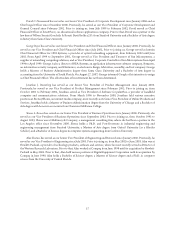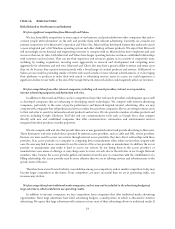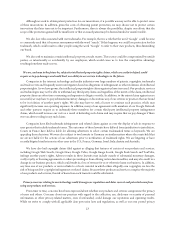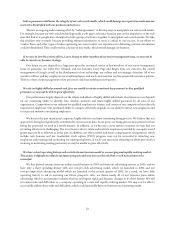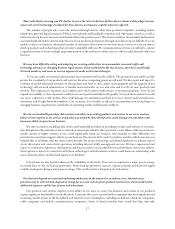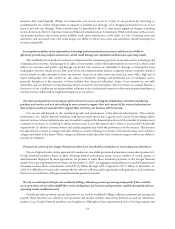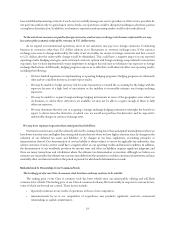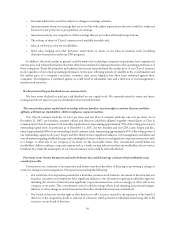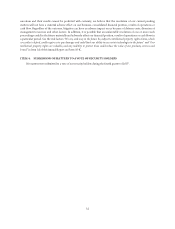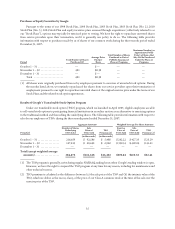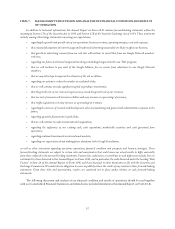Google 2007 Annual Report Download - page 41
Download and view the complete annual report
Please find page 41 of the 2007 Google annual report below. You can navigate through the pages in the report by either clicking on the pages listed below, or by using the keyword search tool below to find specific information within the annual report.More individuals are using non-PC devices to access the internet. If users of these devices do not widely adopt versions
of our web search technology developed for these devices, our business could be adversely affected.
The number of people who access the internet through devices other than personal computers, including mobile
telephones, personal digital assistants (PDAs), smart phones and handheld computers and video game consoles, as well as
television set-top devices, has increased dramatically in the past few years. The lower resolution, functionality and memory
associated with alternative devices make the use of our products and services through such devices more difficult. If we are
unable to attract and retain a substantial number of alternative device users to our web search services or if we are slow to
develop products and technologies that are more compatible with non-PC communications devices, we will fail to capture
a significant share of an increasingly important portion of the market for online services, which could adversely affect our
business.
We may have difficulty scaling and adapting our existing architecture to accommodate increased traffic and
technology advances or changing business requirements, which could lead to the loss of users, advertisers and Google
Network members, and cause us to incur expenses to make architectural changes.
To be successful, our network infrastructure has to perform well and be reliable. The greater the user traffic and the
greater the complexity of our products and services, the more computing power we will need. We have spent and expect to
continue to spend substantial amounts on the purchase and lease of data centers and equipment and the upgrade of our
technology and network infrastructure to handle increased traffic on our web sites and to roll out new products and
services. This expansion is expensive and complex and could result in inefficiencies or operational failures. If we do not
expand successfully, or if we experience inefficiencies and operational failures, the quality of our products and services and
our users’ experience could decline. This could damage our reputation and lead us to lose current and potential users,
advertisers and Google Network members. Cost increases, loss of traffic or failure to accommodate new technologies or
changing business requirements could harm our operating results and financial condition.
We rely on bandwidth providers, data centers and others in providing products and services to our users, and any
failure or interruption in the services and products provided by these third parties could damage our reputation and
harm our ability to operate our business.
We rely on vendors, including data center and bandwidth providers in providing products and services to our users.
Any disruption in the network access or colocation services provided by these providers or any failure of these providers to
handle current or higher volumes of use could significantly harm our business. Any financial or other difficulties our
providers face may have negative effects on our business. We exercise little control over these vendors, which increases our
vulnerability to problems with the services they provide. We license technology and related databases to facilitate aspects
of our data center and connectivity operations including internet traffic management services. We have experienced and
expect to continue to experience interruptions and delays in service and availability for such elements. Any errors, failures,
interruptions or delays in connection with these technologies and information services could harm our relationship with
users, adversely affect our brand and expose us to liabilities.
Our systems are also heavily reliant on the availability of electricity. If we were to experience a major power outage,
we would have to rely on back-up generators. These back-up generators may not operate properly and their fuel supply
could be inadequate during a major power outage. This could result in a disruption of our business.
Our business depends on continued and unimpeded access to the internet by us and our users. Internet access
providers may be able to block, degrade or charge for access to certain of our products and services, which could lead to
additional expenses and the loss of users and advertisers.
Our products and services depend on the ability of our users to access the internet, and certain of our products
require significant bandwidth to work effectively. Currently, this access is provided by companies that have significant and
increasing market power in the broadband and internet access marketplace, including incumbent telephone companies,
cable companies and mobile communications companies. Some of these providers have stated that they may take
27


